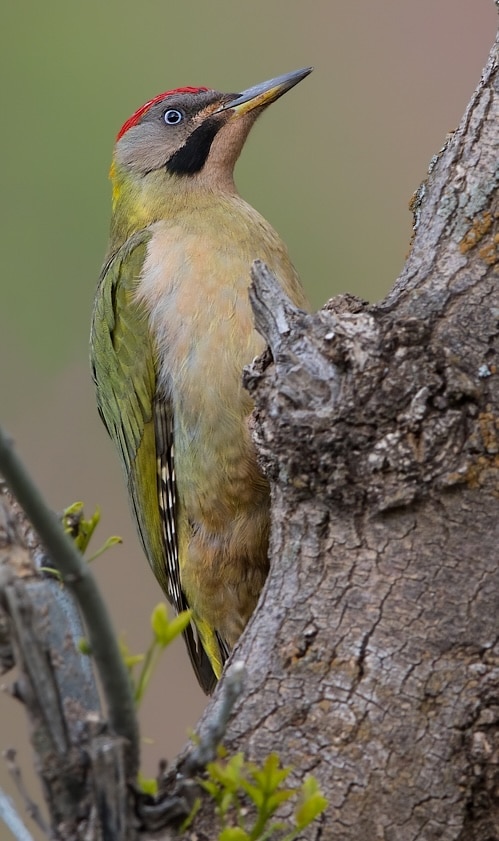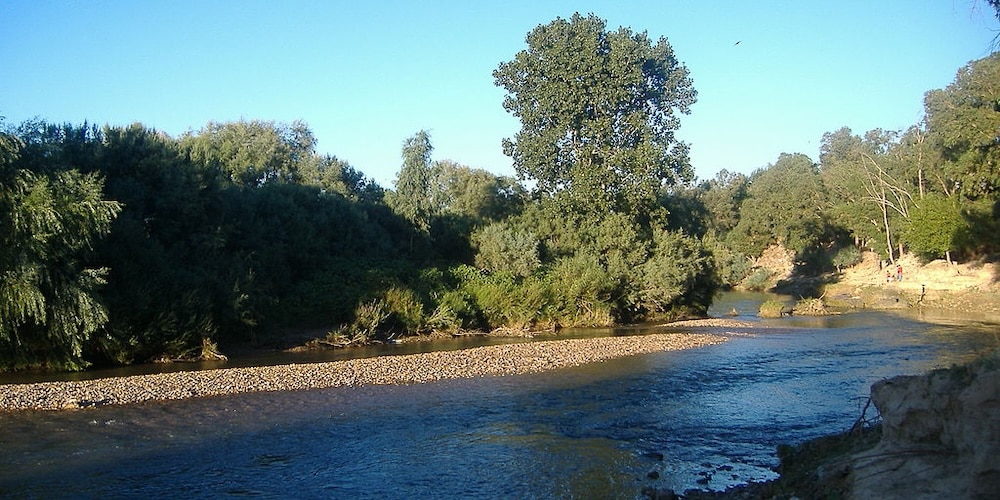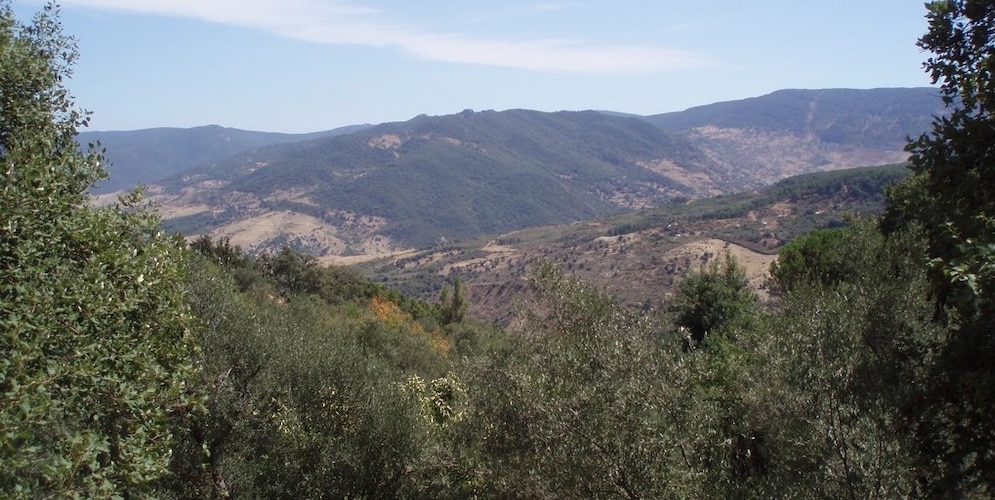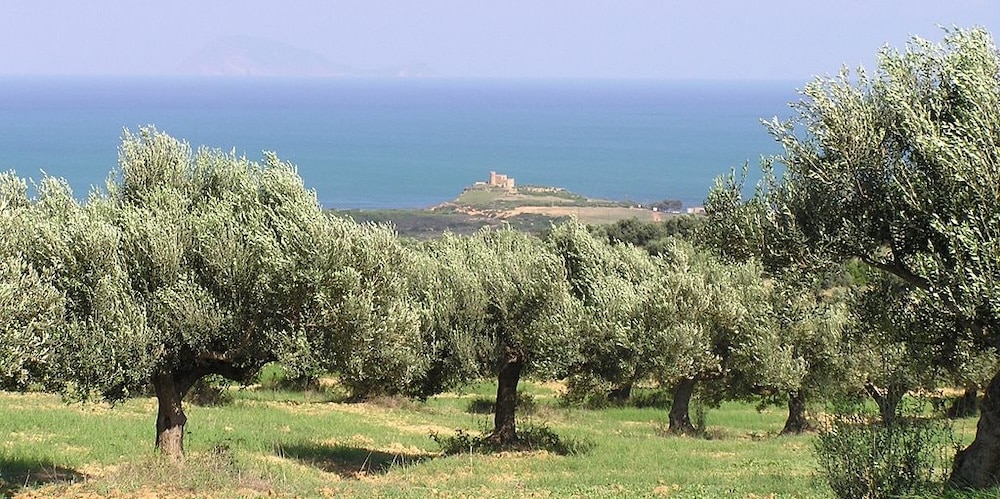Tunisian Republic

Tunisia is a country in the Maghreb region of North Africa situated on the Mediterranean coast of North Africa, midway between the Atlantic Ocean and the Nile Valley. It is bordered by Algeria to the west and southwest, Libya to the southeast, and the Mediterranean Sea to the north and east. Tunisia also shares maritime borders with Italy through the islands of Sicily and Sardinia to the north and Malta to the east. It features the archaeological sites of Carthage dating back to the 9th century BC, as well as the Great Mosque of Kairouan. Known for its ancient architecture, souks, and blue coasts, it covers over 163,600 km2 (63,170 square miles), and has a population of c.12.35 million. It contains the eastern end of the Atlas Mountains and the northern reaches of the Sahara Desert; much of its remaining territory is arable land. Its 1,300 km (810 mile) of coastline includes the African conjunction of the western and eastern parts of the Mediterranean Basin. An abrupt southern turn of its shoreline gives Tunisia two faces on the Mediterranean. Tunisia is home to Africa’s northernmost point, Cape Angela. Located on the northeastern coast, Tunis is the capital and largest city after which the country is named and has more than 2.5 million inhabitants. It is built on a hill slope down to the lake of Tunis at the crossroads of a narrow strip of land between Lake Tunis and Séjoumi.
The official language of Tunisia is Modern Standard Arabic. The vast majority of Tunisia’s population is Arab and Muslim. Vernacular Tunisian Arabic is the most spoken, and French also serves as an administrative and educational language in some contexts, but it has no official status.

Medjerda River – ©Pmgforever CC BY-SA 3.0 via Wikimedia Commons
Though it is relatively small in size, Tunisia has great environmental diversity due to its north-south extent. Its east-west extent is limited. Differences in Tunisia, like the rest of the Maghreb, are largely north-south environmental differences defined by sharply decreasing rainfall southward from any point. The Dorsal, the eastern extension of the Atlas Mountains, runs across Tunisia in a northeasterly direction from the Algerian border in the west to the Cape Bon peninsula in the east. North of the Dorsal is the Tell, a region characterized by low, rolling hills and plains, again an extension of mountains to the west in Algeria. In the Khroumirie, the northwestern corner of the Tunisian Tell, elevations reach 1,050 metres (3,440 ft) and snow occurs in winter.

Khroumirie – ©Aymen CC BY-SA 2.0 via Wikimedia Commons
The Sahel, a broadening coastal plain along Tunisia’s eastern Mediterranean coast, is among the world’s premier areas of olive cultivation. Inland from the Sahel, between the Dorsal and a range of hills south of Gafsa, are the Steppes. Much of the southern region is semi-arid and desert.
In maritime terms, the country claims a contiguous zone of 24 nautical miles (44 kilometres), and a territorial sea of 12 nautical miles (22 kilometres).
Tunisia’s climate is Mediterranean in the north, with mild rainy winters and hot, dry summers. The south of the country is desert. The terrain in the north is mountainous, which, moving south, gives way to a hot, dry central plain. The south is semiarid, and merges into the Sahara. A series of salt lakes, known as chotts or shatts, lie in an east-west line at the northern edge of the Sahara, extending from the Gulf of Gabes into Algeria. The lowest point is Chott el Djerid at 56 feet below sea level and the highest is Jebel ech Chambi at 5,066 feet.
Birding Tunisia
Tunisia is home to five terrestrial eco-regions: Mediterranean conifer and mixed forests, Saharan halophytics, Mediterranean dry woodlands and steppe, Mediterranean woodlands and forests, and North Saharan steppe and woodlands.
Despite its relatively small size, Tunisia has great geographical and climactic diversity. The Sahil is a plain along Tunisia’s eastern Mediterranean coast famous for its olive monoculture. Inland between the Dorsal and a range of hills south of Gafsa, are the Steppes. There are woodlands and wetlands and savanna, but much of the southern region is semi-arid Sahel becoming desert proper at the edge of the Sahara.

Cap Bon Olive Groves – ©Nicholas Gosse CC BY-SA 4.0 via Wikimedia Commons
The country has a well-managed system of national parks and protected areas. One way and another there are some first-class places to see birds in Tunisia. The Gulf of Gabès hosts the largest gathering of migratory waders in the Mediterranean, bringing together more than 330,000 birds. The Cap Bon area, jutting out into the Mediterranean towards Sicily, is a very good spot for birdwatching. Migration takes place in spring and the commonest species recorded are the European Honey Buzzard, the Western Marsh Harrier and the Black Kite. Also Short-toed Snake Eagles, Lesser-spotted Eagles, Egyptian Vultures, Storks and Cranes are regularly observed at the site.

Ichkeul National Park – ©Marc Patry CC BY-SA 3.0 IGO via Wikimedia Commons
Ichkeul National Park is one of the top birding destinations in the country encompassing Lake Ichkeul is an important stopping-over point for hundreds of thousands of migrating birds each year. Among the lake’s visitors are ducks, geese, storks, and flamingoes. However, dams have sharply reduced the freshwater inflow to the lakes meaning that in the marshes, much of the reedbeds, sedges, and other fresh-water plant species have been replaced with salt-loving plants. These changes have produced a sharp reduction in the migratory bird populations, which depend on the mix of plants that used to exist. Other sites with high species numbers include Sulayman Lagoons, Sebhika Kelbia, Bou-Hedma National Park etc.
-
Wikipedia
GNU Free Documentation License
https://en.wikipedia.org/wiki/Tunisia
-
Number of bird species: 417
(As at February 2025)
-
Avibase
PDF ChecklistThis checklist includes all bird species found in Tunisia , based on the best information available at this time. It is based on a wide variety of sources that I collated over many years. I am pleased to offer these checklists as a service to birdwatchers. If you find any error, please do not hesitate to report them. -
E-Bird
PDF ChecklistThis checklist is generated with data from eBird (ebird.org), a global database of bird sightings from birders like you. If you enjoy this checklist, please consider contributing your sightings to eBird. It is 100% free to take part, and your observations will help support birders, researchers, and conservationists worldwide. -
Wikipedia
Annotated ListThis is a list of the bird species recorded in Tunisia. The avifauna of Tunisia include a total of 421 species.
-
Birds of Europe, North Africa, and the Middle East
| A Photographic Guide | By Frédéric Jiguet & Aurélien Audevard | Princeton University Press | 2017 | 47 pages, 2200 colour photos, colour distribution maps | ISBN: 9780691172439 Buy this book from NHBS.com -
Birds of Tunisia - Oiseaux de Tunisie
| By Paul Isenmann | Societé d'Etudes Ornithologiques de France | 2005 |Paperback | 432 pages, 200 colour photos, 150 maps | ISBN: 9782950654892 Buy this book from NHBS.com
-
African Bird Club
WebsiteThe variety of ecological zones means that Tunisia, despite its limited area, enjoys a relatively high level of biodiversity. About 393 species of bird have been recorded, 187 of them breeding. Most species are of Palearctic or desert origin. During the migration and wintering period, because of the large number and extent of its wetlands, Tunisia hosts a considerable number of waterbirds, including rare and threatened species -
Association Les Amis des Oiseaux
WebsiteImmeuble CERES, 23 rue d’Espagne, 1000 Tunis. + 216 1 350875; aao.capbon@gnet.tn [Website cannot be viewed without 'Flash']
-
*National Parks
InformationSatellite ViewWith a view to preserving its ecological heritage, Tunisia has embarked on a voluntarist policy for the protection of its ecosystems and its biodiversity. Eight natural areas identified as priority zones have been established as national parks. -
*Protected areas of Tunisia
InformationSatellite ViewInteractive links to biosphere reserves, parks, Ramsar site etc... -
IBAs
WebsiteSatellite ViewTunisia is a major area of concentration for migrants including soaring species like birds of prey, European White Stork Ciconia ciconia and Common Crane Grus grus. In spring they move northwards through the country, concentrating at El Haouaria at the tip of Cape Bon before continuing their 146 km journey across the Mediterranean to Italy. In this period up to 40,000 individuals of 23 species of raptor may be observed including threatened species such as Pallid Harrier Circus macrourus and Lesser Kestrel Falco naumanni. In addition to this huge concentration, thousands of passerines cross Tunisia during the autumn and spring migrations and are observed in coastal areas and oases -
NP Bou-Hedma National Park
InformationSatellite ViewEndangered species that have been reintroduced here include scimitar oryx (Oryx dammah), addax (Addax nasomaculatus), ostrich (Struthio camelus camelus) and dama gazelle (Gazella dama mhorr). -
NP Chambi
InformationSatellite ViewIt protects the flora and fauna surrounding Mount Chambi (Djebel Chambi), the highest mountain peak (1,544m above sea level) in Tunisia. The parks has no permanent rivers or streams, but it is one of the last refuges of the endangered Cuvier's gazelle and home to vulnerable Barbary sheep. The park is also the site of notable plant life (holm oak and Cotoneaster nummularia, Aleppo pine, and Stipa tenacissima) and birds (including the Tunisian crossbill, the Egyptian vulture, Bonelli's eagle, and he peregrine falcon, among others). -
NP Ichkeul
InformationSatellite ViewThe lake and wetlands of Ichkeul National Park are an important stopping-over point for hundreds of thousands of migrating birds each year. -
NP Jebil
InformationSatellite ViewJebil National Park Map showing the location of Jebil National ParkMap showing the location of Jebil National Park Location Tunisia Coordinates 32°54′4″N 9°9′25″ECoordinates: 32°54′4″N 9°9′25″E Area 1,500 km2 Established 1994 Jebil is a national park in Tunisia situated within the Sahara desert. Covering an area of 150,000 hectares, it is the country's largest national park and makes up most of the southern part of the country. Though large, it is relatively new having been designated a national park in 1994 (unofficially since 1984). It is the only national park within the Sahara desert proper
-
eBird
SightingseBirding This Month
-
Birding Tunisia
Local Tour CompanyWe are a company specialized in developing and operating professional guided birdwatching trips in Tunisia -
NatureTrek
Tour OperatorA 10-day wildlife holiday to the wetlands, savannahs and deserts of a scenic and varied North African land. -
Rockjumper
Tour OperatorWe currently have no scheduled tours running in Tunisia. Have you considered contacting our Tailor-made tours department instead? -
Tunisian National Tourist Office
Local Tour ArrangerImmerse yourself in the heart of some parts of Tunisia that most tourists, especially those in a hurry, never get to see.
-
2018 [03 March] - R. Falkner
ReportThe four of us set off from my hotel in Tunis at 7.00am for Zaghouan, spotting on the way, a colony of Lesser Kestrels nesting and displaying on the very well preserved Roman aqueduct alongside the road. Here too were a few Spotless Starlings, many Spanish Sparrows and Hoopoe. Male White Storks were nest building on top of telegraph poles... -
2018 [05 May] - Max Berlijn
PDF ReportAnnotated list -
2019 [06 June] - Sash Tusa
PDF ReportA long weekend trip made 17-20 June 2019, largely to the Tunis area. The weather was hot, but overcast, with the odd spot of rain, and quite high winds. -
2020 [03 March] - Mark Beevers
PDF Report...starting first at Tazerka Lagoon, where there were several flocks of Greater Flamingos, which Tarek our local guide was determined we would stop to look at. We got past that hurdle and started to see a few things, the most notable being a Peregrine having a go at a Western Marsh Harrier, a Green Sandpiper and a singing Corn Bunting... -
2022 [10 October] - Roland van der Vliet
PDF Report...Wed 26 October: at site in early morning. No sign of the eagle owl unfortunately but still some nice birds. Highlights were a family of Fulvous Babbler and a Greater Hoopoe-lark. From 08:30, I had breakfast at the Mabrouk hotel where a House Bunting kept me company. After that, it was already time to drive north towards Sousse, via Guermasa (via the back road starting at circa 5 km from Chenini), Ghomrassen, Kasr Hadar and Beni Khedache. Lost my way to Kasr Hallouf a bit but found it in the end. From there to Tichine and Matmata. From Matmata back to Sousse...
-
MaghrebOrnitho
InformationArticles about birds and birding in Tunisia.
-
North Africa Birds
BLOG

